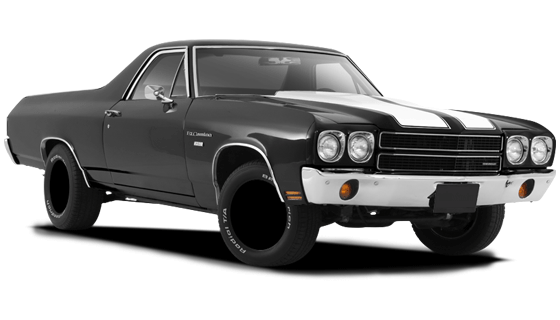Business in the front, party in the back
Known as the “business in the front, party in the back” vehicle to some, the classic Chevrolet El Camino combined both style and functionality in one vehicle. The El Camino had the body of an Impala with the Sedan pickup-truck back end and was one of the most iconic muscle cars of the 60’s and 70’s.
While the body style of the El Camino didn’t make its debut on the North American market until 1957 with the Ford Ranchero, the first company to actually build a coupe utility was Ford Australia back in 1934. In 1935 the Australian subsidiary of General Motors’, Holden, came out with a Chevrolet coupe utility as well. Later, from 1937 to 1939, Studebaker manufactured the Coupe’ Express.
Chevrolet introduced the Cameo Carrier pickup truck in 1955, and while it was a type of light-duty pickup like the Chevrolet Task Force, it had fiberglass rear fenders, a great interior, slick two-tone paint and a V8 engine and automatic transmission. During this time GMC had the Suburban Carrier with all the same features. In 1957 Ford introduced the Ford Ranchero. Chevrolet would respond to this competition with the 1959 El Camino.
When the El Camino production began in 1959, the Ford Ranchero had already been in production for two years. During 1959, Chevrolet introduced the bat-wing Chevys and the El Camino was available with any of the trim and drivetrain options that the other cars had. The chassis was Chevrolet’s “Safety-Girder” X-frame design which was introduced in 1958. Chevy would describe the El Camino as “more than a car, more than a truck” and it was promoted as the first Chevrolet pickup built with a steel bed floor, which was corrugated sheet metal. It had a payload rating ranging from 650 to 1150 pounds and gross weights from 4400 to 4900pounds.
As for performance, the engines offered were a 283-cid Turbo Jet V8 with 2-barrel or 4-barrel carburetion, Turbo-Thrust 348-cid V8s with 4-barrel or triple 2-barrel carburetors producing 335 bhp and 250 and 290 bhp 283 cube Ramjet Fuel Injection V8s.
In 1959 only 22,246 El Caminos were produced, but that was still more than the Ford Ranchero which sold around 14,000 units that year. In fact, there were only 21,706 Rancheros made in 1957.
In 1960 a more conservative design came out. There seat was made of cloth with vinyl facings, and the trim shade options were grey, green and blue. Fuel-injected engines were gone and the 283-cid V8 was tuned-down for fuel economy, dropping the rating down to 170 bhp.
Unfortunately, sales were an abysmal 14,163 in total for 1960. With a total first generation production of 36,409, General Motors decided enough was enough and discontinued the model.
fun facts:
The name El Camino means “The Road” in Spanish.
While many call the El Camino a car, it is actually classified as a truck in North America.
The 1960 model El Camino started at just $2366 for the six-cylinder model, with a V8 upgrade with a two-barrel 283 available for another $107.00
Some believe the reason for the lack of sales in 1960 was the baby-boomer generation. The El Camino was a cross-over that didn’t carry enough passengers, with no more than three people being able to ride comfortably.
The El Camino got an upgrade
Chevrolet discontinued the first generation of El Camino in 1960 due to its falling sales and a changing market. Four years later, in 1964, the new mid-size El Camino was resurrected.
From the B-pillars forward the El Camino was identical to the Chevelle. Both a six-cylinder 194 engine with 120 horsepower rating and a 230 cubic inch engines with 155 horsepower rating were available. The fuel-injected version with 375hp was not available for the El Camino. The V8 was a 283 cubic-inch Chevy small block with two-barrel carb and 195 horsepower with options such as a 220-horsepower 283 with four-barrel carburetor and dual exhausts. Chevrolet also included the option two different versions of the 327 cubic inch small block V8 rated at 250 and 300 horsepower. It had both the Chevelle and El Camino badges, it was marketed as a new utility vehicle.
In 1965 the El Camino got an upgrade with the higher performance version of the 27 engine rated at 350 horse power. In 1966 the 396 cubic inch V8 was added to the El Camino, rated from 325 to 375 horse power. Comparing engines, the 1965 327 ran low 15s in a ¼ mile at about 90mph, but the 1966-1969 models kicked it up to the high 14s.
1966 saw the addition of a new instrument panel with the classic horizontal sweet speedometer in the new 1966 El Camino. Add to this the stronger V-shaped front end and sleek bench interior and the rubber floor mat design from the Chevelle 300 series, and you had style. The custom El Caminos had the Chevelle Malibu plush seats, a cloth-and-vinyl or all-vinyl bench, rich carpeting and the option of the highly styled Strato bucket seats and console, and an optional tachometer.
In 1965 the El Camino got an upgrade with the higher performance version of the 27 engine rated at 350 horse power. In 1966 the 396 cubic inch V8 was added to the El Camino, rated from 325 to 375 horse power. Comparing engines, the 1965 327 ran low 15s in a ¼ mile at about 90mph, but the 1966-1969 models kicked it up to the high 14s.
1966 saw the addition of a new instrument panel with the classic horizontal sweet speedometer in the new 1966 El Camino. Add to this the stronger V-shaped front end and sleek bench interior and the rubber floor mat design from the Chevelle 300 series, and you had style. The custom El Caminos had the Chevelle Malibu plush seats, a cloth-and-vinyl or all-vinyl bench, rich carpeting and the option of the highly styled Strato bucket seats and console, and an optional tachometer.
The upgrades kept coming in 1967, with new air shocks, a new grille, new trim and front bumper design, disc brakes, Turbo 400 3-speed automatic transmission, and a collapsible steering column that made this second generation El Camino a head turner. The L35 engines sold by Chevrolet that year numbered 2,565 were in one of the two El Camino series. The L34 and L78 were available in either El Camino. The Turbo-hydro 400 (TH400) 3-speed automatic was an available option, while the manual 3-speed transmission was the standard transmission available, along with the 2-speed Powerglide and either M20 wide ratio or M21 ratio 4-speed manual Muncie transmissions. There were only 500 El Caminos with the 396 4-speed sold. Other El Camino engines had the standard 230 Turbo-Thrift Six (140 horsepower) and 283 Turbo-Fire V8 (195 horsepower) or optional 327 Turbo-Fire V8s (275 and 325 horsepower). A vinyl roof option was available, and air-adjustable shock absorbers were introduced.
fun facts:
The name El Camino means “The Road” in Spanish.
While many call the El Camino a car, it is actually classified as a truck in North America.
In 1965, upgrading from the 250 bph 327 to a 300 bhp cost a mere $140. For another $200 an El Camino owner could kick up to the 350 bhp.
1966 an El Camino could be order with a 396 but was still not an Super Sport
Evel Knievel used a white 1964 El Camino to carry motorcycles in
1964-1967 El Camino had unique front sheet metal in every year
1966 Pontiac built a porotype version of an El Camino using a Grand Prix
Chevrolet decided to up their game
Chevrolet decided to up their game with the third generation of El Camino starting in 1968. Based on the 4-door sedan station wagon wheelbase, the longer sleeker El Camino was introduced. It had the same interior trim as the Chevelle Malibu and a similar exterior. This was the year of the new higher-performance Super Sport SS396 El Camino. There was both a 325hp and a 350hp version of the TurboJet 396, and the 375 hp L78 was an option. Standard in all engines was the 3-speed manual transmission, with a 4-speed or automatic as an option.
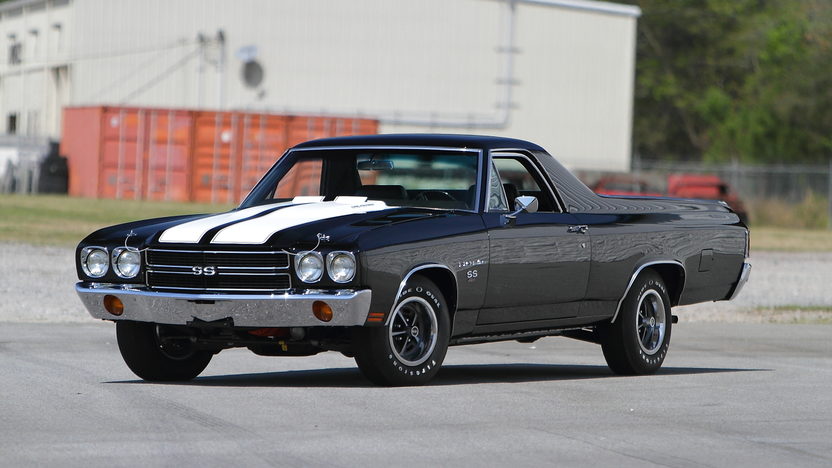 In 1969, the Chevrolet 350 V8 was used in the El Camino for the first time. The front end of the El Camino was rounded and a single bar connecting the quad headlights was added. There was a new grille and front bumper, and the rear back-up lights were located in the tailgate. There were two body colors, still popular today with classic El Camino collectors, exclusive to the SS models; Monaco Orange and Daytona Yellow. The Super Sport had a 265 hp or 325 hp 396 cubic inch V8 tucked under a stylized double-domed hood and blacked-out grille with the iconic SS on the front. Power windows and locks were available.
In 1969, the Chevrolet 350 V8 was used in the El Camino for the first time. The front end of the El Camino was rounded and a single bar connecting the quad headlights was added. There was a new grille and front bumper, and the rear back-up lights were located in the tailgate. There were two body colors, still popular today with classic El Camino collectors, exclusive to the SS models; Monaco Orange and Daytona Yellow. The Super Sport had a 265 hp or 325 hp 396 cubic inch V8 tucked under a stylized double-domed hood and blacked-out grille with the iconic SS on the front. Power windows and locks were available.
A new SS396 was introduced in 1970, which displaced the 402 cubic inch. Interestingly, the emblems still read 396. Chevrolet decided to super-charge some El Caminos with ¼ mile time in the lower 13 second range at almost 105mph, with the LS6 454 CID engine. This engine was rated at 450 horse power and 500lbs per foot of torque!
In 1971 new regulations created a new challenge for the El Camino. Lower-octane fuel was mandated and there was a call for emissions control. In 1971 the El Camino, as well as other Chevrolet vehicles, had no choice but to bow to change, with reduced power, single headlights and lower power outputs. The GM A.I.R system was added to regulate tailpipe emissions. The 402 engine, still previously known as a 396, was renamed the “Turbo Jet 400” with only 300bhp. The El Camino engines available were the 250-6, small block V8s of 307 and 350 cu, and big block V8s of 403 and 454 cu displacements. The 375bhp version and the LS6 454 V8 were no longer available.
With all these changes, the GMC Sprint made its debut in 1971, sharing the same engine and transmission as the Chevy. Visually the El Camino had the same trims inside and out as the Chevy Malibu, including the options of vinyl or vinyl-and-cloth bench seats and carpeting, and the option of all-vinyl Strato bucket seats and center console.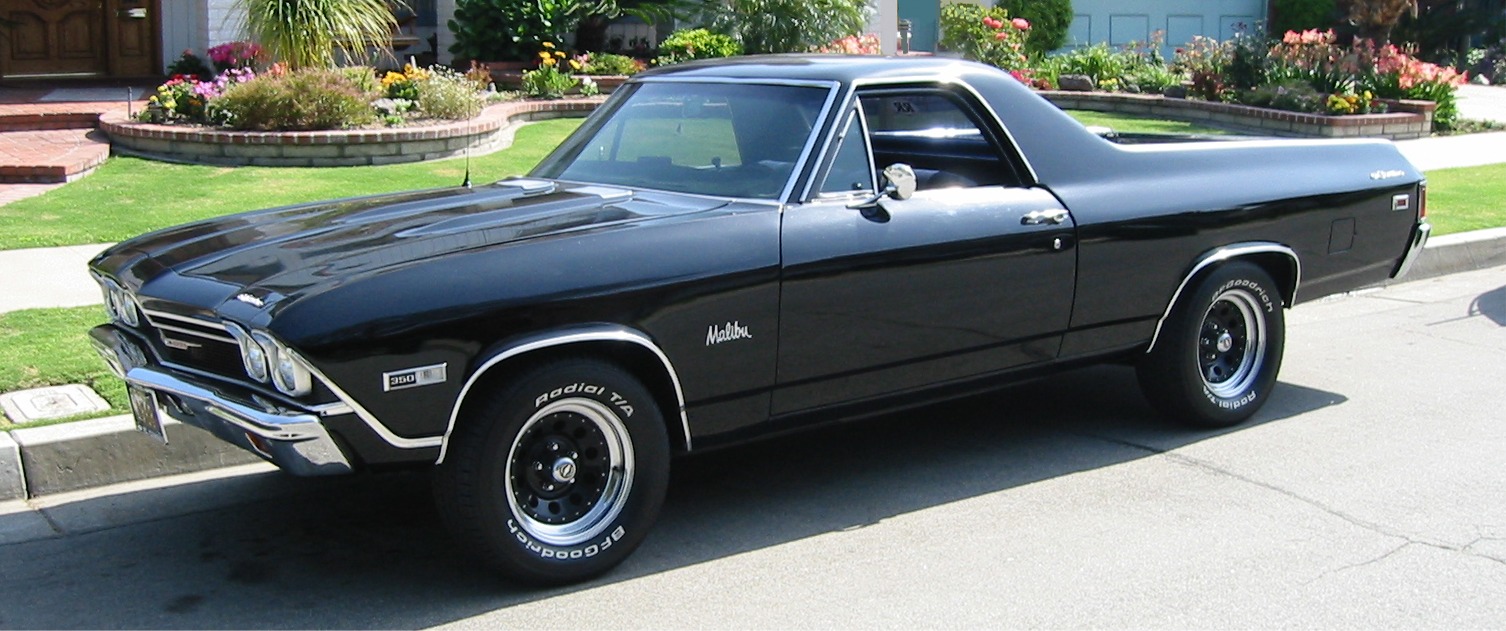
In 1972 all horsepower measurements were now net figures, and all accessories and emission controls were installed. The 350 V8 went down to 175bhp, the 402 to 240bhp, and the 45bhp was dropped to 270bhp. Visually there were few changes. A revised twin-bar grille and single-unit parking and side marker lights on the front end were added. Super Sport equipment was available for order with V8 engines, as well as the base 307 cu version. If you look at the 1972 El Caminos with 454 ci engines, you will see a W as the fifth digit in the VIN. This was the only model available with Super Sport trim this year.
fun facts:
The name El Camino means “The Road” in Spanish.
No SS El Camino were built before the 1968 model year. Only 5190 where built that first year.
1970 Super Sports could be ordered with a 6 cylinder, no gauges, bench seat, just about anything, with one exception, a rear sway bar.
1971 was the first year for GMC version of the SS called a SP
Some famous…or infamous people that owned 68-72 El Camino include Jesse Jackson, Bill Clinton and David Koresh
1968 Specially outfitted El Caminos where used during the U2 spy plane program to “chase” the plane during landing to catch the wings. This is because the U2 plane wings where so long; they could easily touch the ground on landing.
The 1974 El Camino was introduced with more upscale trim
This fourth generation of El Camino starting in 1973 was the largest production of the El Camino after another restyling and a lighter frame and construction. The wagon chassis matched the Chevelle line and energy-absorbing hydraulic front bumper system made it heavier. Both the SS and the base model El Camino had the same interior options as the Chevelle Malibu. Tighter fitting glass, flush outside door handles, acoustical double-panel roof, molded foam seat construction, flow-through power ventilation and other features were added. . Front disc brakes were standard, as well as the ‘Colonnade’ frameless door glass. As for the engine, the 1973 El Camino’s base engine was a 307 3-barrel V8 with 115hp. There were the options of a 350 2-barrel V8 (145 hp), 350 4-barrel V8 (175 hp), and a 454 4-barrel V8 (245 hp). A 3-speed manual transmission was the standard, with a 4-speed manual and Turbo Hydra-Matic 3-speed automatic as options.
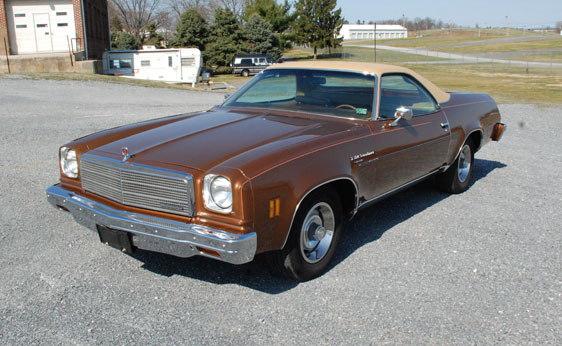 The SS was a trim option and came with a black grille with SS emblem and dual sport mirrors, rally wheels, body-side striping, and 70-series raised white-lettered tires. There were also special instrumentation and SS interior emblems available. This special SS option had a choice of either a 350 or 454 V8 with 4-speed or Turbo Hydra-Matic transmissions.
The SS was a trim option and came with a black grille with SS emblem and dual sport mirrors, rally wheels, body-side striping, and 70-series raised white-lettered tires. There were also special instrumentation and SS interior emblems available. This special SS option had a choice of either a 350 or 454 V8 with 4-speed or Turbo Hydra-Matic transmissions.
The 1974 El Camino Classic was introduced with more upscale trim and a notchback bench seat with optional cloth or vinyl trim folding armrest, better door panels and stylish wood-grained instrument panel trim. The grille was elongated and a swiveling Strato bucket seat, also available in the Chevelle Malibu and Laguna, was now an option. The base engine was now the 350 V8, with the 400 V8 also introduced in 1974. The top engine, however, was the 454, available with the Turbo Hydra-Matic 400 automatic or 4-speed manual transmission.
In 1975 the El Camino suspensions were upgraded, making the El Camino quieter. A new grill, new twin sport mirrors, remote mirrors, cruise control and intermittent wipers were welcome additions. A 250 cu in-line six with 105hp was the base engine and while the 454 CU V8, offering 215 hp, was an option, it wasn’t available in California. This was the year when the Econominder was introduced as an optional instrument package.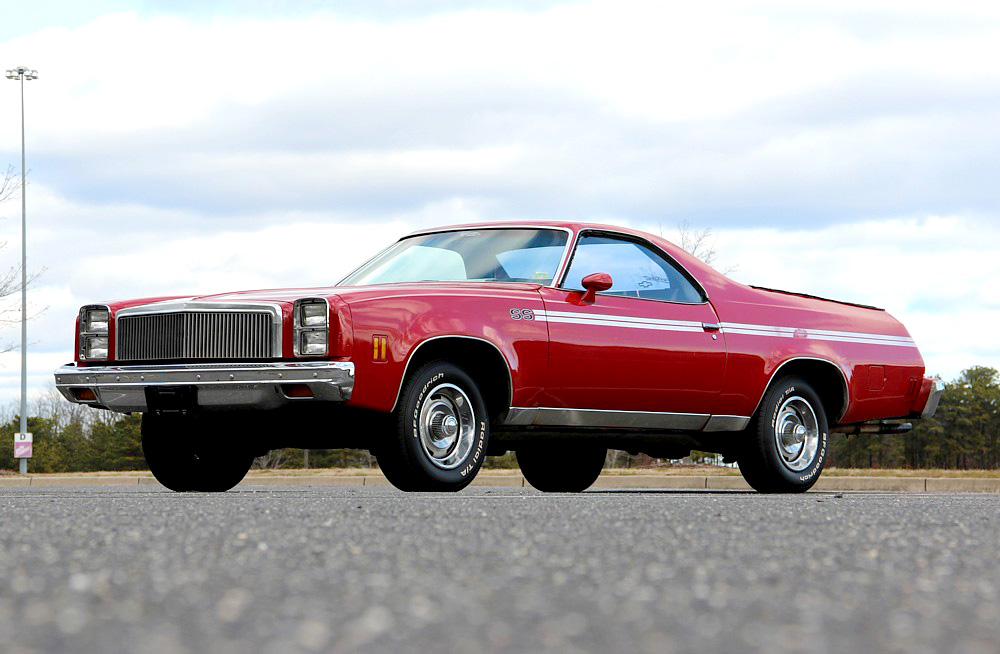
In 1976 the front end redesign included quad stacked headlights. The El Camino engines available were the 250 I6 engine ( which came with either a 3-speed manual or optional Turbo Hydra-Matic automatic transmission), a 305 cu V8 with 140hp, 2- and 4-barrel 350s, and a 400 cu V8 at 175hp. The 350 and 400 came with the Turbo Hyrda-Matic automatic transmission only.
In 1977 the El Camino Classic was the top model. While the SS option did continue, the 400 V8 was discontinued.
Production on the El Camino was stopped in 1987.
The period of 1978 to 1987 is known as the fifth generation in the history of the El Camino.
During this time there were four trim packages available: Classic, Black Knight, Conquista and Super Sport. The Black Knight trim was available in 1978 and from 1979 to 1983 it was the Royal Knight. The change in design, based on the Chevy Malibu, to a smaller body and sharp-edge style and one-inch longer wheelbase came in 1978. While the chassis was unique for the first time, the side door design was shared with the Monte Carlo and the tailgate and bumper were shared with the Malibu station wagon. It had a 200 cu V6 with 95hp as a base engine. In California, however, the base engine was a 231 cu Buick engine due to emission standards. 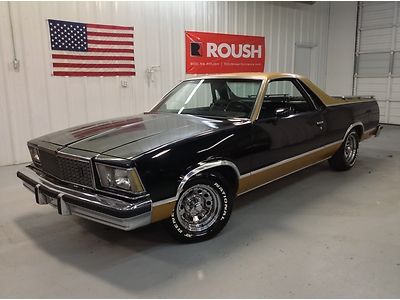
In 1979, while there were no major design changes other than a new divided grill, a new 267 cu V8 was a new option and the 350 cu V8 was once again an available option. In 1980 the base V6 displaced 229 cu, an increase of from 200 in 1979. Horsepower jumped from 94 to 115 and the 267 cu V8 with 125hp and the 305 V8 with 155hp was available again. The standard transmission was a 3-speed floor shifted manual, though the optional 3-speed automatic was most popular.
Engines from 1980 continued through to 1981, with the addition of GM’s Computer Command Control emission system.
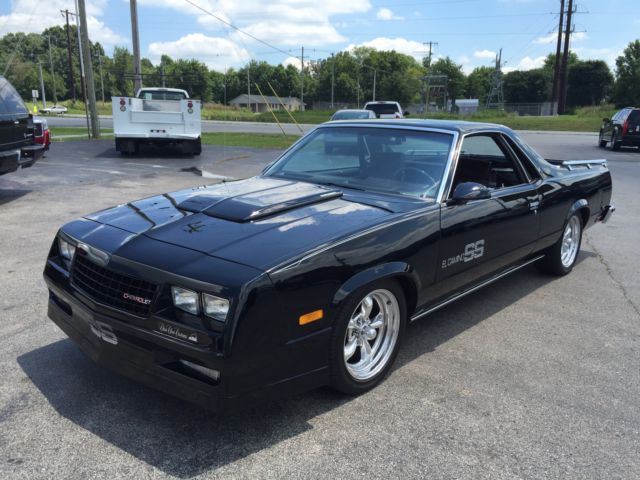 The well-known crosshatch grille and quad rectangular headlights were introduced in 1982. Also introduced this year was the more expensive 350 cu diesel V8with 105hp. In 1983 standard was the Chevy 3.8 liter V6 with 110hp. California had the Buick V6.
The well-known crosshatch grille and quad rectangular headlights were introduced in 1982. Also introduced this year was the more expensive 350 cu diesel V8with 105hp. In 1983 standard was the Chevy 3.8 liter V6 with 110hp. California had the Buick V6.
In 1984 through to 1987 the El Camino SS was offered as a conversion kit and included a front end much like the Monte Carlo SS. The L69 engine package was not included.
When the Chevrolet S-10 true pickup truck began to outsell the El Camino, production on the El Camino was stopped in 1987. To this day the El Camino remains one of the most iconic and historical muscle cars in history.
fun facts:
In 1978 12,027 El Camino SS’ were produced. Peak production of the El Camino was in 1979 when approximately 58,008 were produced. In 1988 only 420 El Caminos were produced.
The A-body pickup was the platform in 1978-1981 and the G-body pickup platform was used in 1982-1987.







